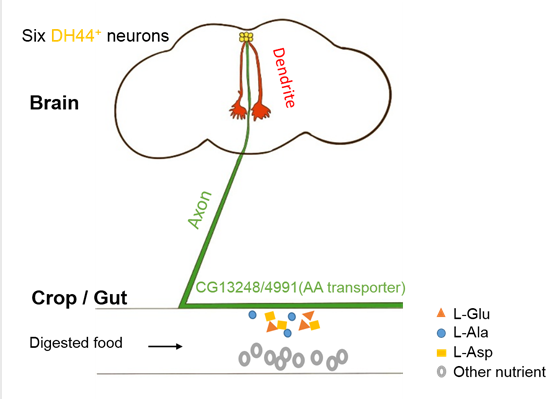On September 12, 2018, Liming Wang Lab published a research paper on Cell Research entitled "A post-ingestive amino acid sensor that promotes food consumption in Drosophila" . This article revealed an amino acid sensor in the central nervous system of fruit fly Drosophila Melanogaster that detects dietary amino acid and promote feeding accordingly.
In this study, we examined the effect of dietary amino acids to modulate food intake in adult fruit flies and sought to identify additional amino acid sensor. We found that dietary amino acids significantly promoted food intake independent of any reported peripheral gustatory system as well as flies’ internal nutritional status. Among all 20 natural amino acids, only three of them, L-Glu, L-Ala and L-Asp enhanced food consumption. Recording the calcium transients in vivo and ex vivo in the fly brain revealed that these three amino acids rapidly and directly activated a small group of neurons expressing diuretic hormone 44 (DH44), the homolog of mammalian corticotropin-releasing hormone (CRH). Genetic silencing and activation of these DH44+ neurons showed that they were both necessary and sufficient for dietary amino acids and yeast extract to promote food consumption.
We further investigated the molecular mechanism underlying the activation of DH44+ neurons by specific dietary amino acids. By single-cell transcriptome analysis, we identified that CG13248, a putative amino acid transporter, was highly expressed in DH44+ neurons and required for dietary amino acids to promote feeding. Furthermore, knocking out two DH44 receptors and DH44 itself completely abolished the increase in food consumption by dietary amino acids, as genetically silencing DH44+ neurons, suggesting that these receptors acted in the same circuitry to regulate amino acid consumption.
In aggregate, we have identified DH44+ neurons as a novel sensor in the fly brain that rapidly detects specific dietary amino acids and promotes amino acid consumption. These dietary amino acids may enter DH44+ neurons via CG13248 to excite these neurons, which may release DH44 neuropeptide and promote feeding through two DH44 receptors in downstream neurons.
This study was funded by the NationalNatural Science Foundation of China, theThousand Young Talents Plan, and the Fundamental Research Fundsfor the Central Universities.

Links:https://www.nature.com/articles/s41422-018-0084-9



